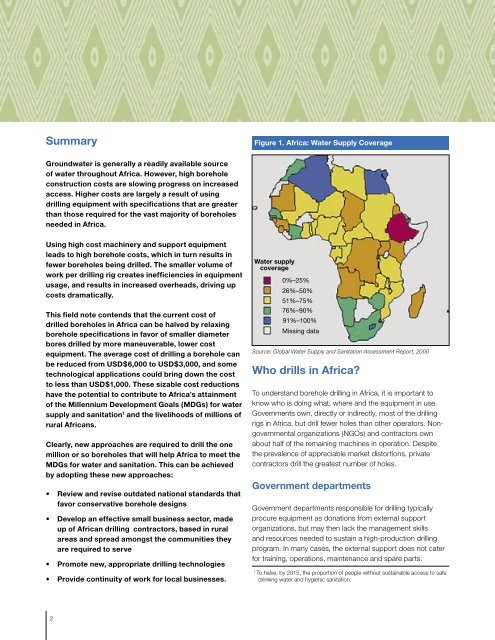Solutions for Reducing Borehole Costs in Rural Africa - International ...
Solutions for Reducing Borehole Costs in Rural Africa - International ...
Solutions for Reducing Borehole Costs in Rural Africa - International ...
Create successful ePaper yourself
Turn your PDF publications into a flip-book with our unique Google optimized e-Paper software.
SummaryFigure 1. <strong>Africa</strong>: Water Supply CoverageGroundwater is generally a readily available sourceof water throughout <strong>Africa</strong>. However, high boreholeconstruction costs are slow<strong>in</strong>g progress on <strong>in</strong>creasedaccess. Higher costs are largely a result of us<strong>in</strong>gdrill<strong>in</strong>g equipment with specifications that are greaterthan those required <strong>for</strong> the vast majority of boreholesneeded <strong>in</strong> <strong>Africa</strong>.Us<strong>in</strong>g high cost mach<strong>in</strong>ery and support equipmentleads to high borehole costs, which <strong>in</strong> turn results <strong>in</strong>fewer boreholes be<strong>in</strong>g drilled. The smaller volume ofwork per drill<strong>in</strong>g rig creates <strong>in</strong>efficiencies <strong>in</strong> equipmentusage, and results <strong>in</strong> <strong>in</strong>creased overheads, driv<strong>in</strong>g upcosts dramatically.This field note contends that the current cost ofdrilled boreholes <strong>in</strong> <strong>Africa</strong> can be halved by relax<strong>in</strong>gborehole specifications <strong>in</strong> favor of smaller diameterbores drilled by more maneuverable, lower costequipment. The average cost of drill<strong>in</strong>g a borehole canbe reduced from USD$6,000 to USD$3,000, and sometechnological applications could br<strong>in</strong>g down the costto less than USD$1,000. These sizable cost reductionshave the potential to contribute to <strong>Africa</strong>’s atta<strong>in</strong>mentof the Millennium Development Goals (MDGs) <strong>for</strong> watersupply and sanitation 1 and the livelihoods of millions ofrural <strong>Africa</strong>ns.Clearly, new approaches are required to drill the onemillion or so boreholes that will help <strong>Africa</strong> to meet theMDGs <strong>for</strong> water and sanitation. This can be achievedby adopt<strong>in</strong>g these new approaches:• Review and revise outdated national standards thatfavor conservative borehole designs• Develop an effective small bus<strong>in</strong>ess sector, madeup of <strong>Africa</strong>n drill<strong>in</strong>g contractors, based <strong>in</strong> ruralareas and spread amongst the communities theyare required to serve• Promote new, appropriate drill<strong>in</strong>g technologies• Provide cont<strong>in</strong>uity of work <strong>for</strong> local bus<strong>in</strong>esses.Water supplycoverage0%–25%26%–50%51%–75%76%–90%91%–100%Miss<strong>in</strong>g dataSource: Global Water Supply and Sanitation Assessment Report, 2000Who drills <strong>in</strong> <strong>Africa</strong>?To understand borehole drill<strong>in</strong>g <strong>in</strong> <strong>Africa</strong>, it is important toknow who is do<strong>in</strong>g what, where and the equipment <strong>in</strong> use.Governments own, directly or <strong>in</strong>directly, most of the drill<strong>in</strong>grigs <strong>in</strong> <strong>Africa</strong>, but drill fewer holes than other operators. Nongovernmentalorganizations (NGOs) and contractors ownabout half of the rema<strong>in</strong><strong>in</strong>g mach<strong>in</strong>es <strong>in</strong> operation. Despitethe prevalence of appreciable market distortions, privatecontractors drill the greatest number of holes.Government departmentsGovernment departments responsible <strong>for</strong> drill<strong>in</strong>g typicallyprocure equipment as donations from external supportorganizations, but may then lack the management skillsand resources needed to susta<strong>in</strong> a high-production drill<strong>in</strong>gprogram. In many cases, the external support does not cater<strong>for</strong> tra<strong>in</strong><strong>in</strong>g, operations, ma<strong>in</strong>tenance and spare parts.1To halve, by 2015, the proportion of people without susta<strong>in</strong>able access to safedr<strong>in</strong>k<strong>in</strong>g water and hygienic sanitation.2
















